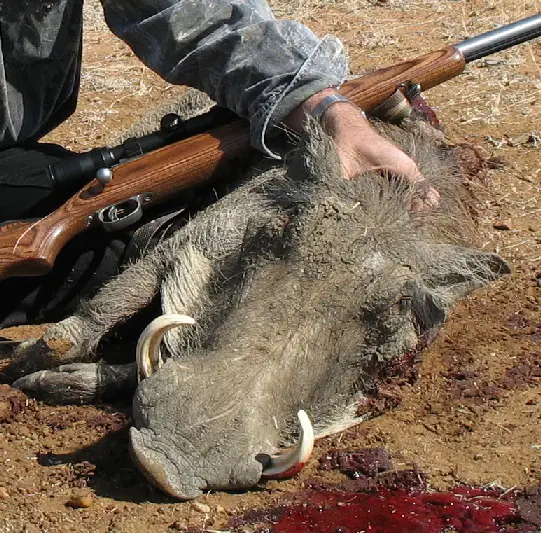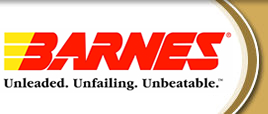


What Barnes for Your Muzzleloader?
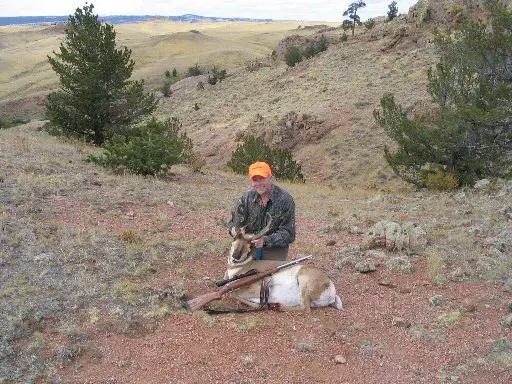
Over the years I've taken more game with Barnes bullets out of muzzleloaders than any other. That includes a lot of hunts, and a lot of rifles. It also includes a wide diversity of ranges: from 8 yards to past 285 yards. The closest shots have been with Barnes saboted projectiles, as well as the very longest. When it comes to muzzleloading projectile performance, the most important criteria is (by far) penetration. Aside from the accuracy afforded by Barnes bullets, nothing penetrates better than a Barnes bullet-- and that is what sets them apart.
I'm far from alone. There is an issue that we deal with, though-- and it has nothing to do with Barnes bullets: bullets that are extremely consistent. All rifles are individuals, and when it comes to muzzleloaders-it is never more self-evident. If we refer to the trusty Lyman Blackpowder Handbook, 2nd. Edition, we can find that ".50 caliber" is defined as a .502 in. bore. Unfortunately, many manufacturers have never read Lyman's, or don't care to have consistent or uniform tolerances. There are no muzzleloading standards: that little fact is never more self-evident when comparing barrel land-to-land dimensions. They vary all over the place, not just brand to brand-- but often by the same manufacturer. So, in an attempt to form a rough guide based on many years of testing, let me attempt to try to make some sense of it all-- if, only a little.
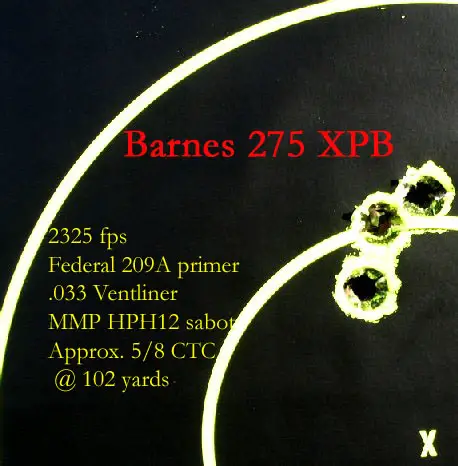
Sabot fit is important. As a generalization, if you want tight groups, you need a tight sabot. Some of the very worst performing projectiles (Powerbelts) are incapable of long range accuracy for reasons of geometry. An undersized conical bullet that rattles down the bore has no consistency when it rattles out at high speed. Any bullet, to perform properly, must load consistently to shoot consistently. Any cocking or canting of the bullet during loading can explain what some refer to as "unexplained flyers." There is always an explanation.
Do you remember the old green ".44 caliber" sabots? Though there are always exceptions, seldom was the "44/50 green" sabot capable of outstanding accuracy with hunting loads. The reason was the "44" wasn't really a 44 at all (nor is a .44 RemMag). It used .429 in. diameter bullets with correspondingly thick .429 / 50 sabots. Sabot material has to be soft enough to enable loading from the muzzle. The more there is of it, the more prone a bullet is to cocking or canting upon loading it in that sabot. Like many gasketing applications, the thinner the gasket-- the better. Unlike a Barnes all-copper bullet that does not change dimensionally, modern sabot materials do of course-- that creates the seal we need.
We do need an interference fit between loaded sabot and bore for accuracy. How much is reasonable question, of course. For maximum accuracy, at least .003 in. to .004 in interference between "loaded sabot" (bullet inside sabot) outside diameter and your barrel's inside diameter (land to land) is a good barometer. If we go to a .006 in. or more interference, we might call it a bit too hard to load. If we drop to a .001 inch interference, our bullets come close to just dropping down the bore, our sabots unable to keep our bullets concentric to the bore on the way out. There goes our accuracy. So, let's start with what I have observed as the "tighter" bores and work our way up.
TIGHT .50 Calibers (Thompson-Center,
and others .4995 in. -.5015 in. barrels)
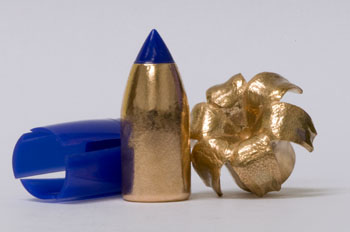
It is the "tight" barrels we hear the most about, of course. Though muzzleloading manufacturers seldom mention it, when using blackpowder, Pyrodex, or Triple Se7en it is mandatory to swab or "spit-patch" after every shot. It means licking a cotton patch, and going up and down your barrel after every shot with that patch on a jag in short "stutter-strokes." Flip the patch over, and repeat. Consistency and accuracy are synonyms. If we don't keep our bore conditions consistent, then we aren't giving our saboted bullets a chance to do their job properly. This is a well-known issue with propellants that leave most of themselves behind as residue: blackpowder residue, for example, is about 55% of its original mass.
Barnes has recently introduced their "TEZ bullet," a flat-based version of their innovative boat tail "TMZ" line. The Barnes "Spitfire T-EZ" comes with a distinctive blue sabot and is the first choice for most Thompson Encores, Triumphs, and Omega's out there. It come in both 250 and 290 grain versions, so a good path is to try a pack of each and let the winner be what groups the best. Recently, I've tested a few Knights with tighter than historical barrels as well, though not as undersized as Thompsons can be. For many current production Knight rifles (Knight KP-1), I've found the Spitfire T-EZ 290 is the most accurate projectile on the market.
MID-RANGE BORES (Knight, some imports, others .5015 -.5025 in. barrels)
The classic MZ-Expander 250 grain bullet is a fine choice. I've had many hundreds of e-mails and phone calls asking if there is a better bullet "on game" than the 250 grain MZ-Expander. My answer is invariably no, nothing substantially better at the most common hunting ranges.
The classic "tube-type" MZ-Expander has a huge hollow-point that offers positive expansion at the most moderate of impact velocities. As Barnes all-copper bullets are longer than the lead pistol bullet types, the feature a longer bearing surface between barrel and bore that keeps this bullet concentric to the bore better than many lead or "cup and core" bullets of the same weight.
There are many reasons why this particular bullet has not been bettered substantially when it comes to terminal performance. Barnes all-copper bullets have essentially 100% weight retention, and that yields far better penetration than the "explodes on impact" thin-jacketed bullets. Wounding ballistics experts, most notably Dr. Martin Fackler, have shown that "cutting" is a far more efficient method of taking out vital organs (and getting to them) than what many bullets are forced to attempt, that being "crushing." The razor-sharp petals of Barnes bullets are just that. Ty Herring of Barnes can attest to how breathtakingly easy they can cut; too bad Ty decided to experiment on himself. The petals really are razor-sharp. Barnes gives out a few expanded samples of their bullets at the various hunting and outdoor shows they participate in. Before they can do that, though, they have to dull the edges of the bullets by tumbling them. Hands cut to pieces are not the souvenirs that Barnes cares to share, of course, so they take that necessary precaution.
LARGER-BORES (.5025 in. - .5035 in.)
Though the trend of late has been to tighter barrels, due to steel variances and other considerations (loose factory specifications) there are a goodly number of .503 barrels (and larger) that, while not hard to load-can be even harder to get to shoot accurately. There is no substitute for geometry, of course, but there are a couple of Barnes products that can generally accommodate them. The 300 grain MZ-Expander, with its extremely long bearing surface, has been a problem solver. It is a long enough bullet that some 1:28 rate of twist barrels may have trouble stabilizing it, but many do. To cite one example, the White Rifles .50 calibers were sold as "White .504's." Doc White went that route partly to pay homage to "standard British calibers" and just maybe to sell proprietary bullets. In any case, the White .504 has a 1:24 rate of twist, and has no problem stabilizing the 300 grain MZ-Expander.
So, there seems to be far more tight barrels out there than "loose ones," but it is hard to account for all the variations that have produced both domestically and abroad. One of the most versatile or forgiving bullets available today is the 290 grain Barnes Spitfire T-EZ already mentioned. Designed to load easily, yes-it might load too easily if you have an oversized bore. There is a solution for you, though, and that is to get HPH-12 sabots from http://mmpsabots.com . Using HPH-12 sabots will give you a couple of extra thousandths in assembled sabot/bullet diameter that is just the ticket for your muzzleloader that happens to have a barrel that has strayed a bit too far open from the norm.
SAVAGE 10ML-II
Some years back, when MMP updated and introduced their Orange .458 / .50 sabot in the course of testing available options, I started shooting the Barnes Original Semi-Spitzer 300 grain #457010 45-70 rifle bullet. The result was pure magic. This combination gave me 3/4 MOA groups at 250 yards out of several Savage 10ML-II's. No fragile pistol bullet, the Barnes Original #457010 has a generous pure copper tubing jacket of thirty-two thousandths thickness. This is no wimpy pistol bullet at all, but a true rifle bullet that shoots lights out. It remains, by far, my favorite bullet out of the Savage 10ML-II. If you aren't familiar with them, the direct link is: http://www.barnesbullets.com/products/rifle/original/ .
They fly flatter and penetrate better than most anything you can shoot out of a Savage 10ML-II-but most importantly, nothing I've found is more consistently accurate. Depending on the conditions, it is either a 300 grain MZ-Expander (to 200 yards) out of the Savage, or the 300 grain Barnes Original out to 300 or so if the conditions are just right. But, if you asked my favorite bullet from "groundhog to grizzly" out of the Savage 10ML-II, it would be the Barnes Original.
IN SUMMARY
There is no one perfect answer for all rifles all the time. In fact, since a good many rifles can not be loaded and shot accurately with the bullets the respective muzzleloading rifle companies themselves sell, no wonder it can sometimes be a bit challenging for the consumer. Barnes has the many options they do not to please themselves, to be sure-- if only one bullet was "the bullet" all the time they could save a bundle on tooling, testing, and R & D time. Barrel variances make the "one bullet" a practical impossibility.
But, it has become easier to make generalizations, though, even if they can only be generalizations. If you have an Encore, Triumph, or an Omega-- a Spitfire T-EZ 250 or 290 is likely the hot ticket. If your rifle is a Savage, the #457010 Barnes Original with Orange MMP .458 / 50 sabots is absolutely worthy of your consideration, along with the classic 300 grain MZ-Expander.
If you have a Knight, either the 250 MZ-Expander or the 290 Spitfire T-EZ is highly likely to get you where you need to be. NEF / H & R's seem to like 290 T-EZ's as well, while Austin & Hallecks have generally done well with 250 MZ-Expanders.
The 300 grain MZ-Expander often solves the situation with bores on the loose side of the spectrum; its long parallel bearing surface compensating and providing concentricity where short, stubby bullets have a rough time.
Finally, let me mention the Spitfires and TMZ yellow-saboted boat tail bullets. They are mid-bore range suitable bullets. Barnes has shown that the boat tail adds substantially to the G1 ballistic coefficient. If you've read this far, you care enough about hunting to want to have the quickest, cleanest kills possible on your game. It is tradition that "velocity and energy at the muzzle" is published, and gets all the hyperbole. As far as I'm concerned, that is not a good thing at all-- unless we intend to shoot things off our muzzles. What really counts is terminal velocity. A bullet that flies better, meaning the boat tail Barnes Spitfires, have less velocity loss downrange. That means that a normal hunter, with 90 - 100 grains by volume of Triple Se7en or Blackhorn 209, can enjoy a flatter trajectory, and higher terminal velocities while using no more propellant, and experiencing no more recoil. It is this niche where the boat tail Barnes series tends to shine.
So hopefully this gives you a bit of a headstart and some time-savings when you consider muzzloading projectile options for your individual inline. As mentioned in many articles, sabots are by nature are far superior to bore-sized bullets. They are automatically; they have to be. Five calibers too big for the same grain weight means a very poor flying projectile, and that is the built in handicap that bore-size projectiles cannot overcome. It also gimps the sectional density of the bullet, which directly translates into inferior penetration-- exactly what we don't want. There are a lot of choices out there, of course, but when it comes to betting a big game animal's life on a bullet-- the only contact between hunter and trophy, it pays to settle only for the best. The best-made muzzleloading bullets on the market are astoundingly cheap hunting success insurance. Still, a little individual trial and error is necessary-- after all, it is our rifles that decide what they like the best. We can only give them the most likely candidates.
Copyright 2008 by Randy Wakeman. All Rights Reserved.



